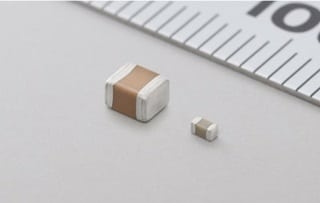source: Murata news
Murata Manufacturing Co., Ltd. has expanded its lineup of chip multilayer ceramic capacitors (GCG series) to extend temperature compensation(class1) and high dielectric constant(class2) at rated voltage 100Vdc for applications using electrically conductive glue*1 for automotive.
New products include class1 type capacitors from 1,000pF to 10,000pF in the 0603 inch size (1.6×0.8mm) and class2 type capacitors at 4.7µF in the 1210 inch size (3.2×2.5mm), with samples ready and mass production underway.
Background
Electronic components located for automotive engine rooms are subjected to harsh operating environments, and therefore electrically conductive glue having high heat resistance and heat cycle durability is used for surface mount of these components. For improved performance with electrically conductive glue, Murata offers a chip multilayer ceramic capacitor (GCG series) that utilizes AgPd electrodes for the external electrodes. This lineup is now being expanded.
Features
AEC-Q200*2 compliant components specifically for use with conductive glue for automotive powertrain and safety equipment applications.
Utilizes newly developed AgPd electrodes for the external electrodes, providing strong bonding with conductive glue even in harsh high-temperature environments.
Applications
- Automotive engine rooms
Representative part numbers
GCG1887U2A102JA01_, GCG32DC72A475KE01_
Electrical characteristics
| 0603 inch size | 1210 inch size | ||
| Temperature characteristic | U2J | X7S | X8L |
| Usage temperature range | -55~+125℃ | -55~+125℃ | -55~+150℃ |
| Rated Voltage | 100Vdc | 100Vdc |
100Vdc
( with voltage derating )
|
| Capacitance | 1,000~10,000pF | 4.7μF | 4.7μF |
External size
0603 inch size:1.6×0.8mm( T=0.8mm)
1210 inch size:3.2×2.5mm( T=2.0mm)
Explanation of terms
*1. Electrically conductive glue: glue that reduces stress on circuit boards and components due to expansion and contraction caused by temperature change.
*2.AEC-Q200: Test standards for reliability sought for automotive electrical parts, as decided by the Automotive Electronics Council.
































